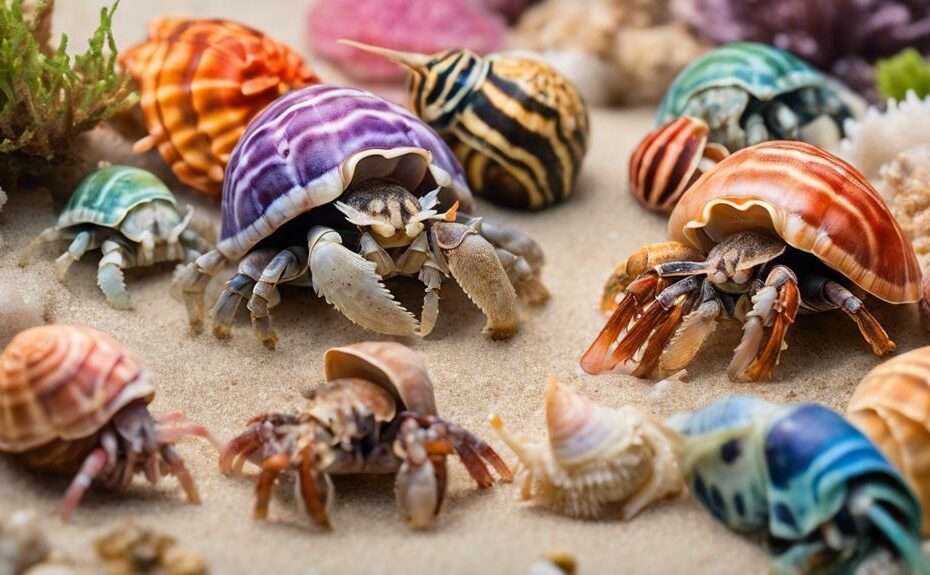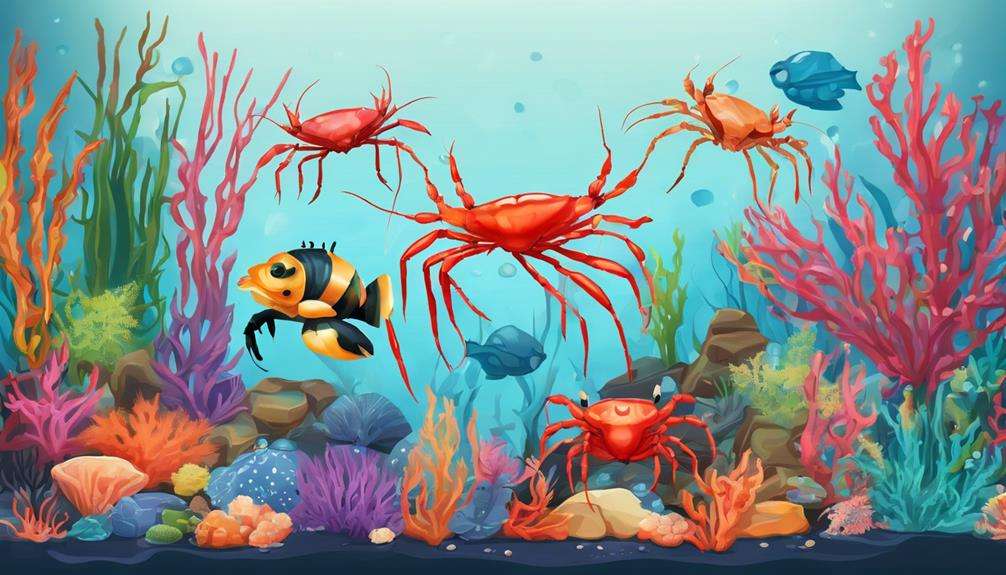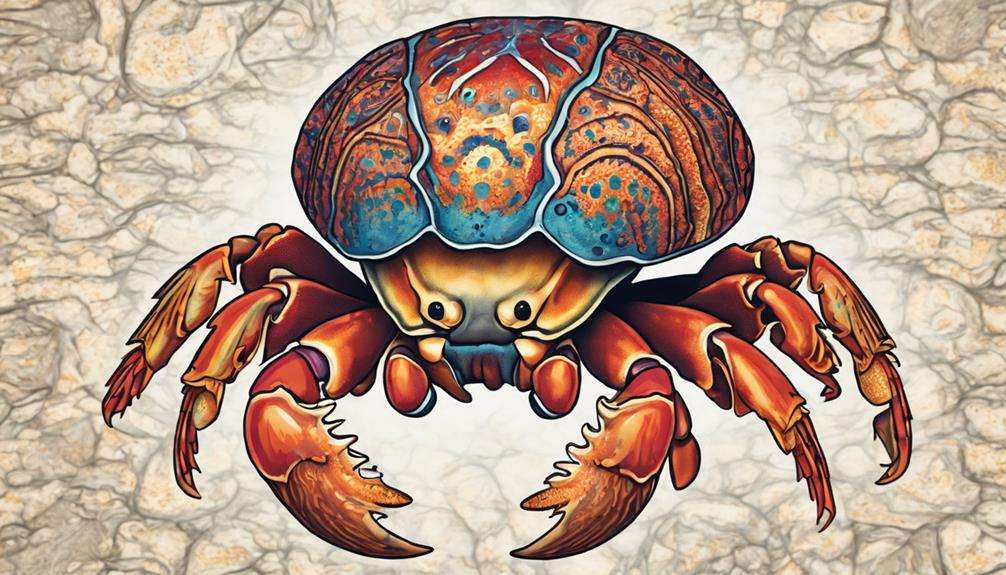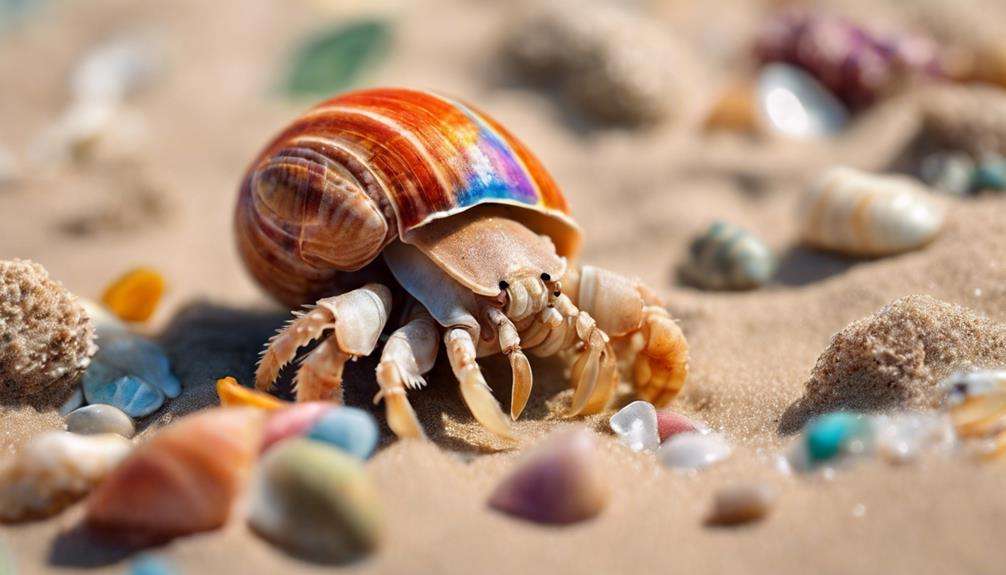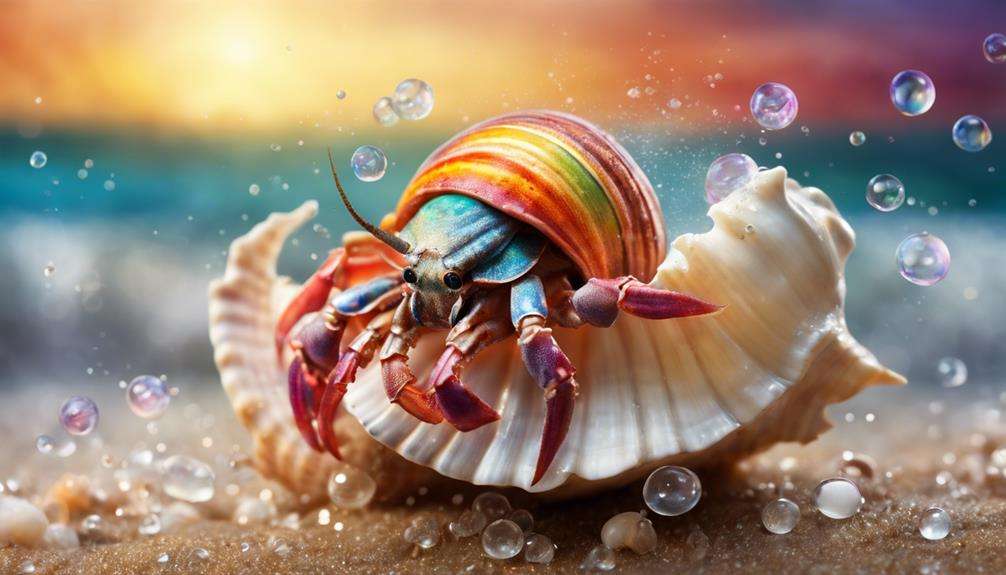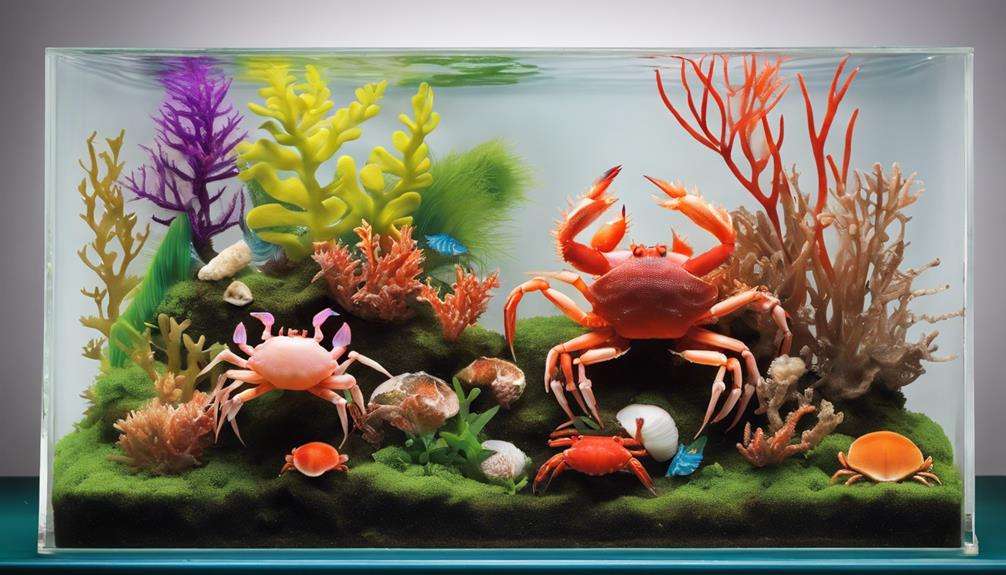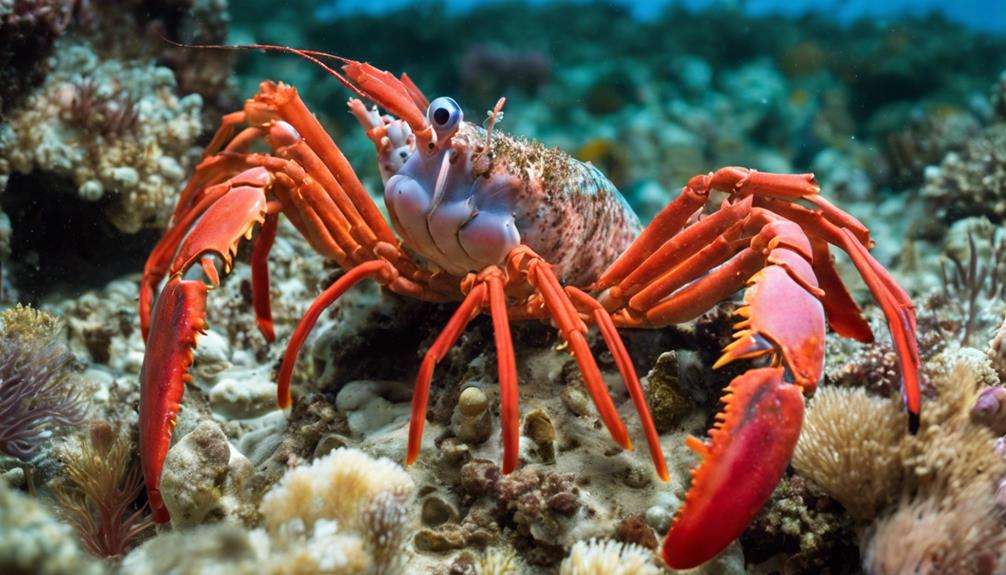Imagine a miniature underwater ballet unfolding in your aquarium, a graceful dance of tiny creatures moving effortlessly through the water. These crustaceans, so delicate yet resilient, hold secrets to why they are favored by many aquarists.
Their ability to thrive in diverse conditions and simple care requirements make them a popular choice for beginners, but what exactly sets them apart? Let's explore the intriguing reasons behind why these crustaceans are known for their ease of care, offering a glimpse into the fascinating world of aquatic pet keeping.
Key Takeaways
- Hermit crabs and shrimp are efficient scavengers, reducing maintenance.
- Crustaceans like Amano and cherry shrimp adapt well to various water conditions.
- Low-maintenance requirements make shrimp and hermit crabs perfect for beginners.
- Regular water parameter checks and proper diet ensure the health of these crustaceans.
Unique Traits of Distinctive Crustaceans
Distinctive crustaceans exhibit a range of unique traits that contribute to their ease of care in aquarium settings. Hermit crabs, for example, are efficient scavengers capable of consuming various foods in captivity. Their scavenging nature aids in maintaining tank cleanliness by eliminating leftover food and debris.
Amano shrimp, on the other hand, are known for their algae-controlling abilities in planted tanks. By feeding on algae, they reduce the need for additional maintenance, making them a valuable addition to aquarium ecosystems. Additionally, Amano shrimp are adaptable to different water conditions, further enhancing their ease of care in captivity.
Cherry shrimp, with their low-maintenance requirements, are also popular among aquarists. Their ability to breed easily in aquariums and their tolerance to a variety of water parameters make them a hassle-free choice for both beginner and experienced hobbyists. These unique traits of shrimp and hermit crabs make them ideal candidates for aquarium enthusiasts seeking easy-to-care-for crustaceans.
Easy Maintenance Tips for Crustaceans
To ensure the optimal care of crustaceans in your aquarium, implementing easy maintenance tips is essential. When it comes to water quality, regular checks for parameters like pH and hardness are crucial. Crustaceans, such as shrimp and crayfish, are adaptable to various water conditions, making maintenance easier.
Adding live plants to the aquarium not only enhances the aesthetic appeal but also helps maintain water quality by absorbing nitrates and providing hiding spots for your crustaceans.
Feeding your crustaceans is simplified by their ability to consume standard flake fish foods. Supplementing their diet with brine shrimp or frozen mysis shrimp can provide essential nutrients, especially for crayfish. It's important to ensure that the water is free from pollutants and debris, as crustaceans are sensitive to changes in water quality.
Suitable Habitat Requirements for Crustaceans
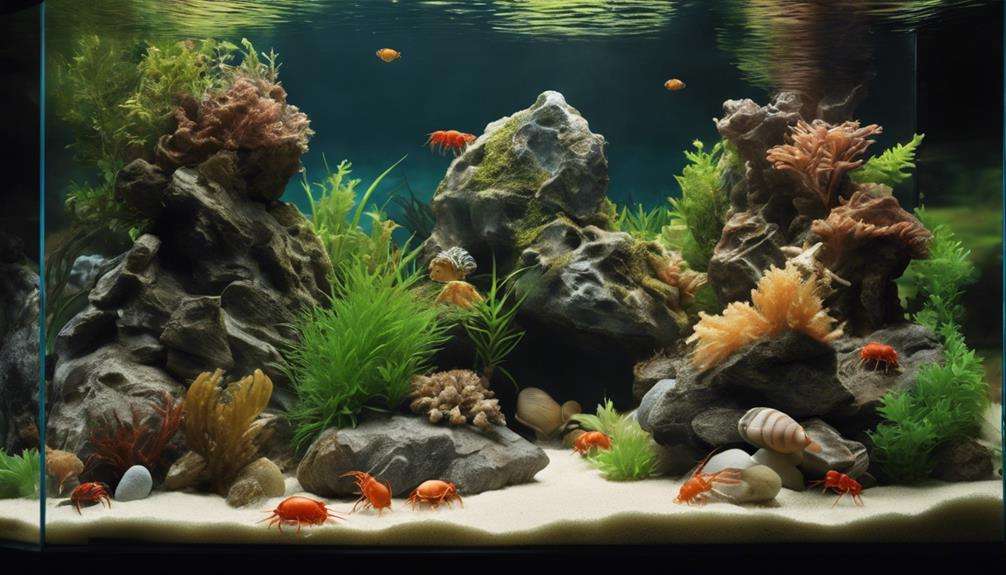
Crustaceans, such as shrimp and crayfish, require specific habitat conditions to thrive, encompassing factors like tank size and decor. These crustaceans do well in nano tanks with ample hiding spots to provide security.
It's important to note that crayfish are best kept solitary due to their aggressive tendencies towards tank mates. When it comes to their diet, plant matter should be included to ensure their overall health. One of the reasons these crustaceans are easy to keep is their adaptability to various water conditions, making them suitable for beginner aquarists.
Additionally, providing hiding spots in the tank is crucial, especially after molting, as they're vulnerable during this phase. By maintaining suitable tank water conditions, offering appropriate decor, and considering their molting as they grow, you can create a habitat that promotes the well-being of these fascinating crustaceans.
Feeding Guidelines for These Crustaceans
When catering to the dietary needs of freshwater crustaceans like shrimp and crayfish, consider feeding them standard flake fish foods as a primary option. Shrimp and crayfish are omnivores, meaning they can consume both plant and animal matter. While standard flake fish foods can be a suitable primary source of nutrition, crayfish, in particular, may benefit from more substantial foods like frozen mysis shrimp to meet their dietary requirements adequately.
These crustaceans are natural scavengers and will readily feed on algae, fallen leaves, and other organic matter present in the tank. To ensure their health and well-being, it's essential to provide plant matter in their diet. However, it's crucial to make sure that the plant matter is suitable for their consumption and doesn't contain any harmful chemicals or pesticides.
Common Health Concerns and Care Solutions
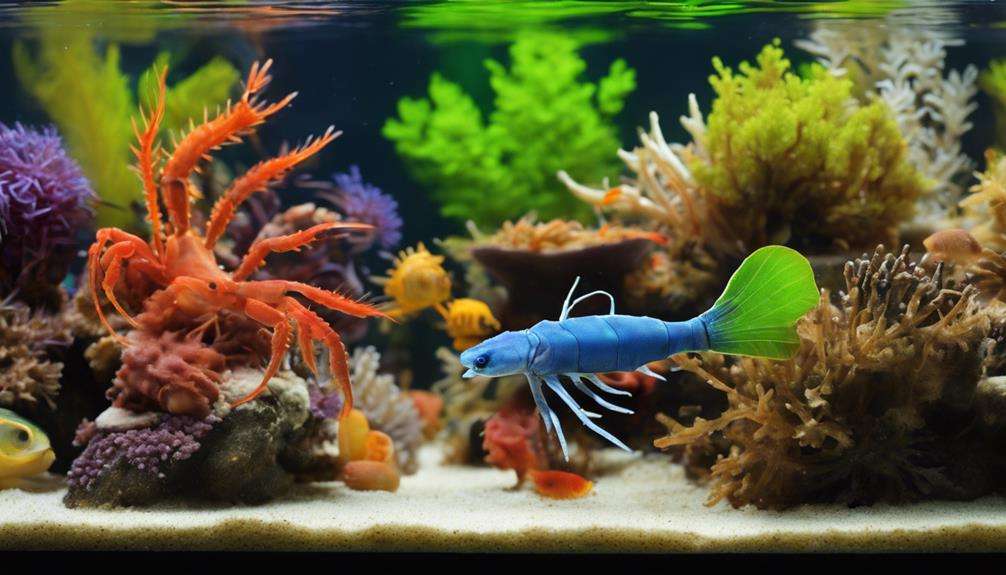
How can you effectively address common health concerns in freshwater crustaceans? When caring for freshwater crustaceans, it's crucial to be aware of potential health issues that may arise.
Here are three key strategies to tackle common health concerns and ensure the well-being of your crustaceans:
- Color Fading: Monitor the water parameters closely to ensure they're within the optimal range for your crustaceans. Adequate water quality, appropriate diet rich in carotenoids, and regular water changes can help maintain vibrant colors in your freshwater crustaceans.
- Loss of Appetite: Offer a varied diet that includes sinking pellets and live or frozen foods to entice crustaceans to eat. Providing a diverse range of food options can help stimulate their appetite and ensure they receive essential nutrients for overall health.
- Spots/Fungus on Body: To address spots or fungus on the body of crustaceans, maintain clean water conditions and promptly quarantine any sick individuals. Treat affected crustaceans with suitable medications as recommended by a veterinarian specializing in aquatic species to prevent the spread of disease and promote recovery.
Frequently Asked Questions
What Is the Easiest Crab to Care For?
The easiest crab to care for is the Caribbean hermit crab. Provide best habitats with sand and shells, feed a varied diet, and handle gently. Keep water fresh and monitor temperature. Enjoy observing their climbing and digging behaviors.
What Is the Advantage of Crustaceans?
Low maintenance and fascinating, crustaceans offer unique behaviors as interactive pets. Their adaptability to water conditions and simple diets make them a joy to care for. Embrace the wonder of these aquatic companions.
How Do Crustaceans Protect Themselves?
Crustaceans protect themselves using various strategies such as exoskeleton strength for armor, camouflage tactics to blend in, and predator evasion through quick movements. These defense mechanisms help them survive in their environments and avoid threats.
Why Should We Care About Crustaceans?
You should care about crustaceans for marine conservation, sustainable seafood, and ocean biodiversity. Being aware of their role in the ecosystem and promoting their wellbeing contributes to the health of aquatic environments.
Conclusion
In conclusion, caring for these crustaceans is as simple as a walk in the park. With their adaptability, easy feeding habits, and beneficial cleaning abilities, they make a great addition to any aquarium.
By providing them with a suitable habitat, proper nutrition, and monitoring their health, you can enjoy the company of these fascinating creatures with ease. Just like a well-oiled machine, keeping these crustaceans happy and healthy is a breeze.
